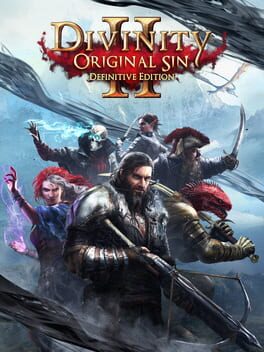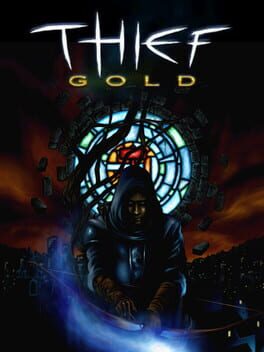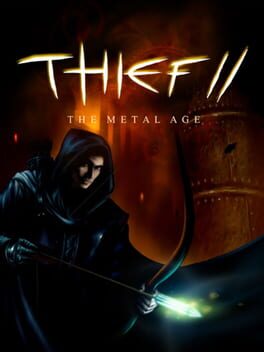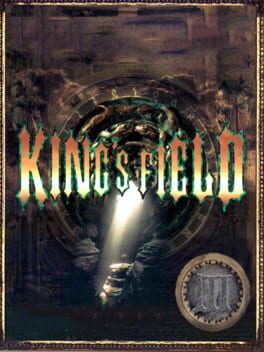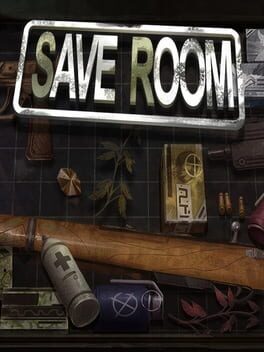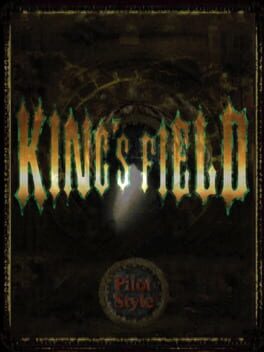Watermalloc
Bio
Fan of stealth and horror games, RPGs, and platformers.
I don't like highly-granular rating systems in general, so my star ratings are just a rough approximation of my thoughts:
★: hated it
★★: didn't like it
★★★: liked it
★★★★: really liked it
★★★★★: loved it
Fan of stealth and horror games, RPGs, and platformers.
I don't like highly-granular rating systems in general, so my star ratings are just a rough approximation of my thoughts:
★: hated it
★★: didn't like it
★★★: liked it
★★★★: really liked it
★★★★★: loved it
Badges

Pinged
Mentioned by another user

Liked
Gained 10+ total review likes
Favorite Games
030
Total Games Played
019
Played in 2024
055
Games Backloggd
Recently Played See More
Recently Reviewed See More
Filcher is an impressive homage to the gameplay of the classic Thief games that is bursting at the seams with indie charm. It takes some big risks to mixed effect, and the low budget does hold Filcher back from being a true masterpiece in the genre, but this solo-dev labor of love is largely a blast to play through.
Most of the gameplay mechanics from Thief make a return: you will be sneaking through progressively more secure locations to steal as much loot as possible, and loud gameplay is even more disincentivized than Garrett's already-limited options by removing lethal weapons. You still get analogues for several of the classic tools from Thief: moss spores, a noisemaker toy, and dart gun work similarly to moss, noisemaker, and gas arrows, albeit with much more limited range. There's no mantling this time around, but Sporey, the protagonist, can slide quietly across floors as long as she gets enough of a running start. I do miss mantling dearly, but the sliding mechanic is wonderful, and mastering it allows you to confidently breeze through sections by sliding past guards at the right moment. Though it's not exactly the same as its inspirations, the moment-to-moment gameplay in Filcher is rock-solid, with tons of tension added by the most divisive feature.
If you've looked at the store page or reviews for the game, you're certain to have seen the many complaints about Filcher's lack of saving. Personally, I have mixed feelings about this decision. The missions are designed with the lack of saving in mind, all being completable within about 20 minutes — none of them stretch anywhere near as long as missions like Thieves' Guild from Thief: Gold. This limitation makes the levels incredibly tense, which I love, though the novelty wears a bit thin on the final two which are dramatically more difficult and complex than the rest of the levels before them. I still completed the last levels without too much issue, but I got about halfway through replaying the campaign to get the ghost rank achievement before I decided to shelve the game for now. Getting a ghost rank on a level requires you to play it absolutely perfectly: get all the loot and secrets, don't knock anybody out, and naturally, don't get caught. I enjoyed the tension brought on by the lack of saves in an organic first playthrough where I was ok with making mistakes, but on replays, it wasn't terribly fun to completely restart a relatively long mission after any given screwup. Skill issue, optional achievements, yadda yadda yadda, I know, I just think that the lack of saves does hamper successive playthroughs of the game even though I enjoyed the tension the first time through.
Another gameplay mechanic I did miss from classic Thief games is a store to purchase items and information. It doesn't fit in with Filcher as it's currently designed — the levels can be replayed at any time, and as mentioned above, Sporey's arsenal is more limited than Garrett's — but having an actual gameplay incentive to bag as much loot as possible would have been a nice addition.
Filcher's presentation is pretty great, especially for a solo developer. The art style of the levels and the intro cutscenes draws heavily from noir comics, giving the whole experience a distinct style. The music is simple and mostly driven by a plucky bass, but it fits right in with the atmosphere. I don't mind the 2.5D renderings of the enemies, but I will say that the lack of voice acting for the guards is sorely missed and makes the levels feel more lifeless than they would otherwise. If we are ever blessed with a high-budget Filcher 2, that would be my number one request; it doesn't even need to be as goofy or varied as Thief, just a little something to characterize the goons we're robbing blind. The same goes for the comic panel cutscenes: I love the style, but I wish the characters were voice acted even if animated cutscenes are too big of a stretch for an indie project like this.
Overall, Filcher is a great time, and one of the best stealth games released in the past few years. Though it has a few shortcomings related to its budget and some hotly-debated design decisions, you owe it to yourself to play through this game if you're a fan of Thief or stealth games at large. It's a hardcore but rewarding experience with a true appreciation for the titans of the genre while still putting its own spin on the gameplay and presentation.
Most of the gameplay mechanics from Thief make a return: you will be sneaking through progressively more secure locations to steal as much loot as possible, and loud gameplay is even more disincentivized than Garrett's already-limited options by removing lethal weapons. You still get analogues for several of the classic tools from Thief: moss spores, a noisemaker toy, and dart gun work similarly to moss, noisemaker, and gas arrows, albeit with much more limited range. There's no mantling this time around, but Sporey, the protagonist, can slide quietly across floors as long as she gets enough of a running start. I do miss mantling dearly, but the sliding mechanic is wonderful, and mastering it allows you to confidently breeze through sections by sliding past guards at the right moment. Though it's not exactly the same as its inspirations, the moment-to-moment gameplay in Filcher is rock-solid, with tons of tension added by the most divisive feature.
If you've looked at the store page or reviews for the game, you're certain to have seen the many complaints about Filcher's lack of saving. Personally, I have mixed feelings about this decision. The missions are designed with the lack of saving in mind, all being completable within about 20 minutes — none of them stretch anywhere near as long as missions like Thieves' Guild from Thief: Gold. This limitation makes the levels incredibly tense, which I love, though the novelty wears a bit thin on the final two which are dramatically more difficult and complex than the rest of the levels before them. I still completed the last levels without too much issue, but I got about halfway through replaying the campaign to get the ghost rank achievement before I decided to shelve the game for now. Getting a ghost rank on a level requires you to play it absolutely perfectly: get all the loot and secrets, don't knock anybody out, and naturally, don't get caught. I enjoyed the tension brought on by the lack of saves in an organic first playthrough where I was ok with making mistakes, but on replays, it wasn't terribly fun to completely restart a relatively long mission after any given screwup. Skill issue, optional achievements, yadda yadda yadda, I know, I just think that the lack of saves does hamper successive playthroughs of the game even though I enjoyed the tension the first time through.
Another gameplay mechanic I did miss from classic Thief games is a store to purchase items and information. It doesn't fit in with Filcher as it's currently designed — the levels can be replayed at any time, and as mentioned above, Sporey's arsenal is more limited than Garrett's — but having an actual gameplay incentive to bag as much loot as possible would have been a nice addition.
Filcher's presentation is pretty great, especially for a solo developer. The art style of the levels and the intro cutscenes draws heavily from noir comics, giving the whole experience a distinct style. The music is simple and mostly driven by a plucky bass, but it fits right in with the atmosphere. I don't mind the 2.5D renderings of the enemies, but I will say that the lack of voice acting for the guards is sorely missed and makes the levels feel more lifeless than they would otherwise. If we are ever blessed with a high-budget Filcher 2, that would be my number one request; it doesn't even need to be as goofy or varied as Thief, just a little something to characterize the goons we're robbing blind. The same goes for the comic panel cutscenes: I love the style, but I wish the characters were voice acted even if animated cutscenes are too big of a stretch for an indie project like this.
Overall, Filcher is a great time, and one of the best stealth games released in the past few years. Though it has a few shortcomings related to its budget and some hotly-debated design decisions, you owe it to yourself to play through this game if you're a fan of Thief or stealth games at large. It's a hardcore but rewarding experience with a true appreciation for the titans of the genre while still putting its own spin on the gameplay and presentation.
Because the first King's Field never released outside of Japan, King's Field II is just named King's Field in the US and Europe; the same holds true for the Japanese King's Field III being titled King's Field II internationally. Beyond being silly, this makes Googling information about the first two games incredibly frustrating — these are already old and obscure games, and now you want a tiny, scattered fan community to come to a consensus on the naming scheme? I firmly believe that this should only be referred to as King's Field II, but I am biased by not growing up playing this on the PS1.
It's possible to make a number of comparisons between the design of the first King's Field and the later Soulsborne games, but much more than its predecessor, King's Field II actually feels like a prototypical Dark Souls. Gone are the complicated-but-disconnected series of dungeon floors; this time, the entire game world is open from the get-go, and it's up to the player to decide the order of progression based on what enemies they think they can handle. The number of NPCs has been greatly expanded, and paying attention to their cryptic (and often humorously translated) requests can reward you with gear that aids exploration or bolsters your strength. Whereas the first game pigeonholed you into using the Moonlight Sword and its corresponding Sword Magic to defeat the final boss, this time around, there are a variety of entirely optional hidden weapons and magics that you can discover and use to push through the endgame. All of these elements come together to serve as a strong improvement over the first game, and were it not for the combat and returning quality of life issues (more on that in a bit), I'd say that King's Field II deserves to get talked about in the same breath as the Souls games it inspired well over 10 years after it released.
I do want to praise the level design, because it is truly fantastic for an early 3D console game. While I'm no game historian, this is one of the earliest examples of a first-person Metroidvania I can think of; System Shock, released in 1994, is the only earlier release with such qualifiers that comes to mind. The game begins with the player waking up on a dark beach and with no directions, an ocean with instant-death drop-offs behind you. From there, you are naturally drawn towards a nearby cave, but there are several other dangerous points of interest nearby, such as another cave guarded by a giant squid, that will quickly reinforce the need to return to difficult areas later down the line when you're more powerful. The fact that sections of the world are implicitly gated by the player's strength rather than by a linear sequence of levels (as in the first game) is great. This design philosophy largely continues throughout the entire map: if you have difficulty progressing forward, it usually means it's time to return to an area that scared you off earlier in the playthrough. Also, despite being dramatically larger and more interconnected than the first King's Field — and the fact that there are three different maps with their own coverage of the game world — the level design flows beautifully. Secrets are just as hidden as ever, but I rarely got stuck and needed to consult an online map to move forward unlike the previous outing. Overall, the strong level design does feel like bedrock for the design of the first half of Dark Souls: the simplest path through each area is clear to the player, but secrets and hidden areas require much more dedication to locate. The aesthetic variety does not come anywhere close to Dark Souls — most of the map is fairly repetitive stone hallways — but I chalk that up to the game's age, budget, and target platform more than I do to the vision.
Though the map flows well, that does not mean it's easy to keep track of everything! This is the first game I've ever played where I wish I took notes -- remembering the location of locked chests and NPCs, and the details of NPC questlines, gets more and more mentally taxing the further you progress. As a result, I ended up having to look up where to find somebody several times, which isn't helped by the fact that the scattered villages are all visually identical. This isn't so much a knock on a game as it is advice: if you decide to play this game, be prepared to keep notes as you go if you want to minimize your reliance on external walkthroughs. For the later King's Field games and their adjacent contemporaries, I intend on taking notes and only using the internet if I get truly stuck, as I truly enjoy the thrill of discovery that these games bring.
My biggest complaint about the game is unavoidable: the combat is very outdated and slows down exploration rather than engaging or challenging the player. The tank movement is totally fine, since the enemies are designed around your limited turn speed, but each fight plays out almost exactly the same. Move forward, whack the enemy, back up to dodge their attack, optionally use a magic attack while your stamina is recharging, repeat. For some enemies, you can shake this up by tailgating their ass in a giant circular motion and smacking them repeatedly as a sort of goofy ancestor to a Dark Souls backstab. It doesn't matter what enemy you're fighting; this is how every fight in the entire game plays out unless you're using the bow, which is not engaging either. I actually didn't mind the combat in the first King's Field despite it being functionally identical to the combat in King's Field II, but the fact that King's Field II is several hours longer than its predecessor means that the basic combat is stretched very thin by the end of the game without new mechanics or improvements. The exploration being so good and ahead of its time makes the combat — of which there is no shortage in King's Field II — drag down the experience a bit.
The lack of quality of life features, though not unexpected for the time, has only worsened due to the larger scope of this sequel. Since there is no storage system, your inventory will be bloated by the end of the game unless you sell or discard your consumables and key items. For a gamer with a hoarder mentality like myself, that is completely antithetical to how I play these games, especially since there aren't that many items you can discard unless you're religiously following a walkthrough and know when each item has served its purpose. This bloated inventory system also means that using multiple items sucks. You have to fill up each individual potion flask in your inventory at a fountain, which takes ages; using multiple healing items at once during combat is no different. Items still don't have displayed stats either, so equipping a new piece of loot requires navigating through a few menus and doing needless mental math to make sure you didn't just weaken yourself. Much like the combat, I was more willing to excuse this in the first game when the experience was shorter and From Software had no prior game to build upon, but it's disappointing here, even though it does not come anywhere close to ruining my perception of the game.
Overall, I liked King's Field II and found it to be a memorable experience anchored by the rock-solid exploration, but the combat and outdated user interface make it difficult to recommend to the average person. If you're a rabid fan of the Soulsborne games like myself and want to see the roots of the series, it's a no-brainer to give this game a go, and you'll almost certainly walk away with an appreciation of how From Software was able to further refine the strengths of this game (and patch up the weaknesses) in their later spiritual successors.
It's possible to make a number of comparisons between the design of the first King's Field and the later Soulsborne games, but much more than its predecessor, King's Field II actually feels like a prototypical Dark Souls. Gone are the complicated-but-disconnected series of dungeon floors; this time, the entire game world is open from the get-go, and it's up to the player to decide the order of progression based on what enemies they think they can handle. The number of NPCs has been greatly expanded, and paying attention to their cryptic (and often humorously translated) requests can reward you with gear that aids exploration or bolsters your strength. Whereas the first game pigeonholed you into using the Moonlight Sword and its corresponding Sword Magic to defeat the final boss, this time around, there are a variety of entirely optional hidden weapons and magics that you can discover and use to push through the endgame. All of these elements come together to serve as a strong improvement over the first game, and were it not for the combat and returning quality of life issues (more on that in a bit), I'd say that King's Field II deserves to get talked about in the same breath as the Souls games it inspired well over 10 years after it released.
I do want to praise the level design, because it is truly fantastic for an early 3D console game. While I'm no game historian, this is one of the earliest examples of a first-person Metroidvania I can think of; System Shock, released in 1994, is the only earlier release with such qualifiers that comes to mind. The game begins with the player waking up on a dark beach and with no directions, an ocean with instant-death drop-offs behind you. From there, you are naturally drawn towards a nearby cave, but there are several other dangerous points of interest nearby, such as another cave guarded by a giant squid, that will quickly reinforce the need to return to difficult areas later down the line when you're more powerful. The fact that sections of the world are implicitly gated by the player's strength rather than by a linear sequence of levels (as in the first game) is great. This design philosophy largely continues throughout the entire map: if you have difficulty progressing forward, it usually means it's time to return to an area that scared you off earlier in the playthrough. Also, despite being dramatically larger and more interconnected than the first King's Field — and the fact that there are three different maps with their own coverage of the game world — the level design flows beautifully. Secrets are just as hidden as ever, but I rarely got stuck and needed to consult an online map to move forward unlike the previous outing. Overall, the strong level design does feel like bedrock for the design of the first half of Dark Souls: the simplest path through each area is clear to the player, but secrets and hidden areas require much more dedication to locate. The aesthetic variety does not come anywhere close to Dark Souls — most of the map is fairly repetitive stone hallways — but I chalk that up to the game's age, budget, and target platform more than I do to the vision.
Though the map flows well, that does not mean it's easy to keep track of everything! This is the first game I've ever played where I wish I took notes -- remembering the location of locked chests and NPCs, and the details of NPC questlines, gets more and more mentally taxing the further you progress. As a result, I ended up having to look up where to find somebody several times, which isn't helped by the fact that the scattered villages are all visually identical. This isn't so much a knock on a game as it is advice: if you decide to play this game, be prepared to keep notes as you go if you want to minimize your reliance on external walkthroughs. For the later King's Field games and their adjacent contemporaries, I intend on taking notes and only using the internet if I get truly stuck, as I truly enjoy the thrill of discovery that these games bring.
My biggest complaint about the game is unavoidable: the combat is very outdated and slows down exploration rather than engaging or challenging the player. The tank movement is totally fine, since the enemies are designed around your limited turn speed, but each fight plays out almost exactly the same. Move forward, whack the enemy, back up to dodge their attack, optionally use a magic attack while your stamina is recharging, repeat. For some enemies, you can shake this up by tailgating their ass in a giant circular motion and smacking them repeatedly as a sort of goofy ancestor to a Dark Souls backstab. It doesn't matter what enemy you're fighting; this is how every fight in the entire game plays out unless you're using the bow, which is not engaging either. I actually didn't mind the combat in the first King's Field despite it being functionally identical to the combat in King's Field II, but the fact that King's Field II is several hours longer than its predecessor means that the basic combat is stretched very thin by the end of the game without new mechanics or improvements. The exploration being so good and ahead of its time makes the combat — of which there is no shortage in King's Field II — drag down the experience a bit.
The lack of quality of life features, though not unexpected for the time, has only worsened due to the larger scope of this sequel. Since there is no storage system, your inventory will be bloated by the end of the game unless you sell or discard your consumables and key items. For a gamer with a hoarder mentality like myself, that is completely antithetical to how I play these games, especially since there aren't that many items you can discard unless you're religiously following a walkthrough and know when each item has served its purpose. This bloated inventory system also means that using multiple items sucks. You have to fill up each individual potion flask in your inventory at a fountain, which takes ages; using multiple healing items at once during combat is no different. Items still don't have displayed stats either, so equipping a new piece of loot requires navigating through a few menus and doing needless mental math to make sure you didn't just weaken yourself. Much like the combat, I was more willing to excuse this in the first game when the experience was shorter and From Software had no prior game to build upon, but it's disappointing here, even though it does not come anywhere close to ruining my perception of the game.
Overall, I liked King's Field II and found it to be a memorable experience anchored by the rock-solid exploration, but the combat and outdated user interface make it difficult to recommend to the average person. If you're a rabid fan of the Soulsborne games like myself and want to see the roots of the series, it's a no-brainer to give this game a go, and you'll almost certainly walk away with an appreciation of how From Software was able to further refine the strengths of this game (and patch up the weaknesses) in their later spiritual successors.

